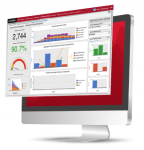Remote Workforce Management – from survive to thrive in 3 easy steps
Richard Pinnington of Calabrio discusses how workforce management means so much more in challenging times.

Many team leaders have become ‘mother hens’ to their work-at-home agents, caring for their wellbeing and motivation. However, those organisations reluctant to let go of their on-premise infrastructures have struggled to cope with a massive influx of calls, channel shift, heightened customer expectations and disruptions to team availability.
Beware of spreadsheets and long live strategic resource planners
Workforce Management (WFM) has come to mean so much more in 2020. Despite a wealth of business continuity and disaster recovery plans, the current health crisis has revealed just how much some businesses have overlooked the importance of the planning function. In the awful event of a key planning individual becoming ill and that person being the only one who understands how the master forecasting and scheduling spreadsheet works, the entire contact centre is at risk. WFM tools that provide complete resource planning visibility and agility are now even more invaluable.
WFM: from survive to thrive in 3 easy steps
It’s time to use the all-round benefits of WFM to ensure your contact centre thrives:

One positive outcome of the pandemic is that contact centres are being more creative with scheduling. Planners are experimenting with new types of shifts such as micro-shifts that are great for home-working. Mid-day humps or overlap with day/night shifts are easier to avoid. However, flexibility remains key. Are agents in the right place at the right time? Are they scheduled against a constantly-changing forecast? Do schedules build in extra time for agents to take care of family or other domestic issues? Are you adding a higher shrinkage to forecasts to compensate for larger numbers of technical issues as agents transition to home-working or physically move between shifts after workstation deep-cleans?
Moving to a cloud-based WFM application gives supervisors and resource planners the control and visibility they need when teams are working remotely. They also provide the perfect solution when preparing for agents to return to the office.


Paying attention to the emotional health of frontline staff is a top priority. Although home working is here to stay, the simple truth is that many contact centre agents don’t have a home environment that is conducive to work and being natural communicators, many miss the human contact of the office.
Fortunately, the latest WEM solutions cover the complete employee lifecycle from recruitment to onboarding, coaching to e-learning, team communications to interactions, task assignments to performance targets, gamification to acknowledgment and reward. Make the most of WEM capabilities to engage and motivate agents through self-service technology that helps puts people in control of their working lives and with flexible schedules that accommodate the stresses of remote working.
For more ideas and inspiration on how remote workforce management can mean so much more than forecasting and scheduling Click Here
 Richard Pinnington is Director, Strategic Channel Partnerships at Calabrio.
Richard Pinnington is Director, Strategic Channel Partnerships at Calabrio.
Calabrio is the customer experience intelligence company that empowers organisations to enrich human interactions. The scalability of our cloud platform allows for quick deployment of remote work models—and it gives our customers precise control over both operating costs and customer satisfaction levels. Our AI-driven analytics tools make it easy for contact centres to uncover customer sentiment and share compelling insights with other parts of the organisation. Customers choose Calabrio because we understand their needs and provide a best-in-class experience, from implementation to ongoing support.
For additional information on Calabrio view their Company Profile

 Richard Pinnington is Director, Strategic Channel Partnerships at Calabrio.
Richard Pinnington is Director, Strategic Channel Partnerships at Calabrio.



